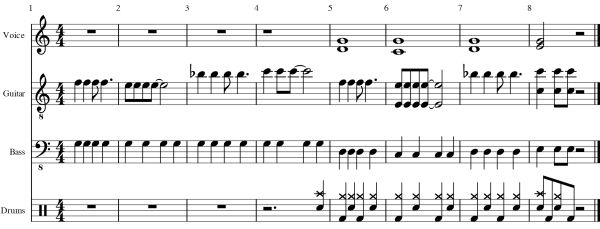Audio: multipart drone (0:16)

multipart drone is a pop band playing a multipart drone in the key of C mixolydian. The multipart drone figure shows the score:
multipart drone shows how a single drone can easily be extended to a multipart drone.
Bars 1-4 are an example of two part harmony and bars 5-8 extend the harmony to multiple parts. There is a single drone in the soprano voice and a series of sustained drones in the alto part which is doubled in the bass part. The guitar also doubles some of its parts. Distributing the drone amongst two voices and two instruments is an effective way to disguise the simplicity of the underlying harmony. Doubling the parts and adding the rhythm of the drums creates a rich timbre overall.
One interesting feature of multipart drone is that it was written without a key. There is no key signature to guide you when you write music. Normally you choose the key, start writing, and away you go. Occasionally, though, you may have a musical idea but no clue what the key is. This was the case with multipart drone. The melody in the guitar part was written without any idea of the key.
Key was worked out after the piece was written. The melody contains the notes Bb, C, E and F. Assuming all four notes are diatonic to a scale and not chromatic then it becomes a matter of working out the name of the scale that contains these notes. The scale that fits the bill is ABbCDEFG. This is the key of F major or one of its relatives. Notes C and G both sound OK as drones, the tonic and the dominant are the two most common drone notes, they are a fifth apart, the interval CG is a fifth, which means C is the tonic and G is the dominant. The key is C mixolydian, a relative of F major.